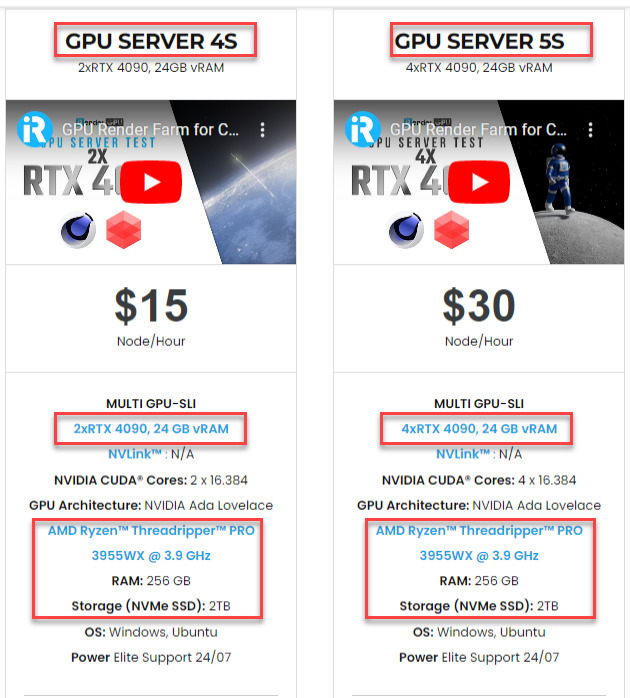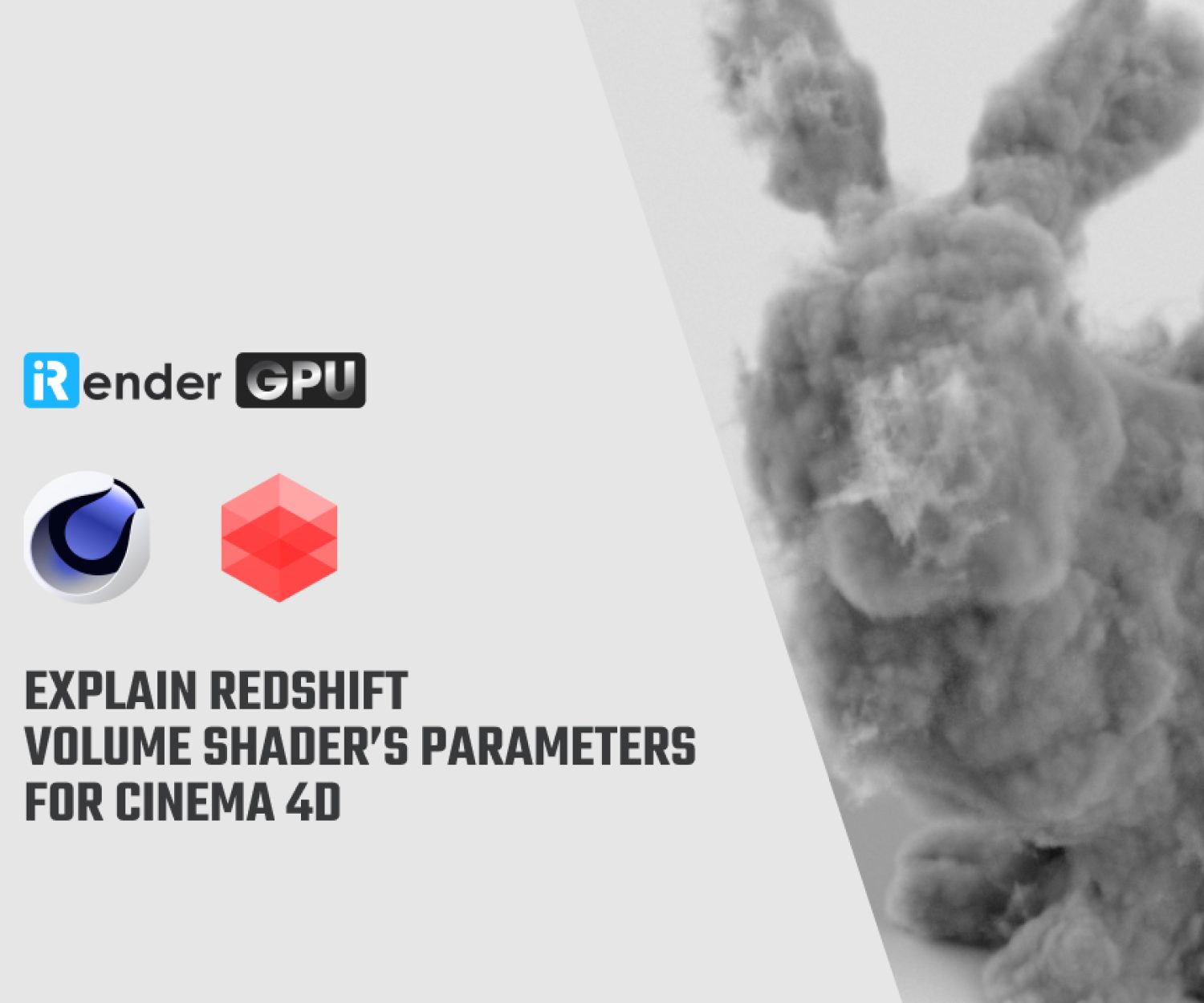Meet Redshift’s advanced System Requirement with iRender Service
Redshift primarily depends on GPU performance because it is a GPU renderer. However, there are some rendering-related processing steps that are reliant on the performance of the CPU, disk, Vram, network,….So in today’s article, let’s see how the multi-GPU configuration that iRender provides for Redshift is considered to meet Redshift’s advanced system requirement.
iRender provides powerful configuration for Redshift
As you may know, iRender provides high-configuration computers for rendering. You will connect to our computers via Window Remote Desktop, and then you will have full control of them, just like you are using your own machines. As your working environment is saved after each use, your working becomes easier than ever.
Currently, iRender provides a variety of configurations for customers to choose based on the size and nature of each project, but in today’s article we will use the newly released configuration of iRender – also the most powerful one so far to discuss. That is GPU server 8S – 6x RTX 4090.
iRender’s services meet Redshift’s advanced System Requirement
CPU
A lower-end CPU can “bottleneck” the overall rendering performance because these processing stages can take a long time depending on the complexity of the scene. Redshift doesn’t require the most cutting-edge CPU, but we do advise using at least a mid-range quad-core processor, like the Intel Core i5. A more powerful CPU, such as the Intel Core i7, is advised if the CPU will be controlling four or more GPUs or batch-rendering multiple frames simultaneously.
It is recommended to use CPU with lots of single-threaded performance. A CPU with fewer cores and a higher clock speed is preferable to one with more cores and a lower speed. That is, compared to a 6 core 3.5 GHz CPU, an 8 core 2.5 GHz CPU will perform significantly worse for Redshift. CPUs with operating frequencies of 3.5GHz or higher are advised. In short:
- Redshift is generally more concerned with GHz than number of cores.
- Consider a higher-end Core i7 or AMD CPU if you plan to install multiple GPUs.
That’s why the CPU AMD Ryzen™ Threadripper™ PRO 3955WX @ 3.9 GHz at irender makes a lot of sense for projects using Multi GPU, especially with Redshift. Enjoy your workstation’s performance to the next level with one of the most powerful high-end desktop processors from AMD.
Multiple GPU scaling
Simply, if your motherboard can accept more than one video card, adding additional video cards greatly improves rendering speed because rendering performance of Redshift scales perfectly with the number of GPUs. The more GPU you have, the faster render you can.
When rendering with Redshift and multiple GPUs, you have two options: you can render a single frame using all your GPUs or you can render multiple frames at once using a combination of the GPUs.
Rendering a single frame with all available GPUs can, in some cases, produce a non-linear performance gain. For example: 4 GPUs might not render exactly 4 times faster compared to rendering with 1 GPU. They might render something like 3 times faster. That’s because there’s a certain amount of per-frame CPU processing involved which cannot be sped up by adding extra GPUs.
To better explain this, consider the following example. Let’s assume that extracting scene data from Maya (which happens solely on the CPU) takes 10 seconds and rendering takes 60 seconds to execute with 1 GPU. So the total rendering time is 70 seconds. Now, if you were to add another 3 GPUs (for a total of 4 GPUs), you would be dividing the 60 seconds of pure rendering time by 4 which is 15 seconds. But you wouldn’t be dividing the 10 seconds of extraction time at all, because all of that is done on the CPU! So the total rendering time would be 10 seconds + 15 seconds = 25 seconds vs the original 70 seconds. I.e. 3 times faster instead of 4.
In comparison to its predecessor, the Nvidia RTX 4090 features a number of improvements, including faster clock speeds, more CUDA cores, third-generation ray tracing cores, and fourth-generation tensor cores. And with the combination of 6 GPU RTX 4090, we can all see an explosion in rendering performance
Disk
Textures (JPG, EXR, PNG, TIFF, etc.) are automatically converted by Redshift to its own texture format, which loads and is used more quickly during rendering. These converted textures are kept in a folder on the local drive. To ensure that the converted texture files can be opened quickly during rendering, we advise using an SSD for that texture cache folder. Redshift has the option to forego all of this caching and open textures directly from their original location (even if that location is a network folder), but we do not advise doing so.
At iRender, all configurations use SSD drives with capacities up to 2TB to ensure stability and compatibility with large projects.
RAM
The memory should be multiplied if you plan to render multiple frames at once (as described in the previous section). For example, if rendering one frame requires 16GB, rendering two frames at once will require about 32GB. This becomes more crucial if you plan to install multiple GPUs on each computer.
Therefore, with 256GB RAM capacity, there’s no doubt that this is what you need from a workstation.
VRAM
GPUs come in multiple VRAM configurations like 8GB/11GB/12GB/16GB/24GB/48GB. The general rule of thumb for Redshift (and other GPU renderers) is “the more VRAM, the better”.
Redshift is efficient when it comes to VRAM utilization. It is able to fit around 20-30 million unique triangles within approximately 1GB of video memory. If a scene contained 300 million triangles, Redshift would normally need approximately 10GB of VRAM. But even GPUs with 8GB of VRAM can render such high poly scenes with Redshift due to its out-of-core architecture (please see our online FAQ for an explanation of “out of core”). However, excessive out-of-core data access can sometimes introduce considerable performance penalties. It is, therefore, preferable to have plenty of VRAM available when rendering high-poly scenes.
Redshift’s out-of-core tech doesn’t cover all possible types of data. Currently, Redshift cannot store volume grids (such as OpenVDB) in an out-of-core fashion. This means that scenes using many hundreds of megabytes of OpenVDB data might require a GPU with more VRAM, otherwise the frame rendering will be aborted.
Another benefit of having lots of VRAM is being able to run multiple GPU applications at once. Apps like Maya’s OpenGL viewport, Chrome (the web browser) and Windows itself can consume considerable amounts of VRAM and leave little memory for Redshift to work with. This is, obviously, less of an issue on GPUs containing plenty of VRAM. For users that can’t afford a GPU with lots of VRAM, a possible workaround is installing an additional (cheaper) GPU which will be used for everything except Redshift. Then, the remaining GPU(s) can be disconnected from the monitor(s) and will, therefore, have the entire VRAM available for rendering with Redshift. Disconnecting a GPU from the monitor is called “headless mode”.
2. iRender - The Best Render Farm for Redshift
About us
iRender is proud to be a professional GPU Accelerated Cloud Rendering Service provider for 3D Render, CGI, and VFX tasks with more than 30,000 clients. We are appreciated in many global rankings (e.g. CGDirector, Lumion Official, Radarrender, InspirationTuts CAD, All3DP, BlenderBaseCamp, and VFX Rendering.)
How does our service work?
We provide high-configuration dedicated servers (physical computers/machines) specifically optimized for GPU rendering. Using our service, you will have complete control over the server(s) you rent through the Remote Desktop application. Therefore, you can customize your creative working environment as you wish. In short, iRender’s server is like your computer in the cloud accessible on any device instantly. You will use its full power for everything. iRender provides useful features to help you switch among the server’s configurations without having to reinstall anything. You can even run multiple servers simultaneously to speed up the renders, not having to re-install anything, either.
Why choose us for your Redshift rendering?
Redshift is a fully GPU-based renderer. This means that the graphic cards (or GPUs) in your system impact how long the renders take to complete. Also, Redshift scales very well with multiple GPUs and can significantly improve your render times. Therefore, the more powerful the GPU, the better, the more GPUs, the faster render will be.
At iRender, we have both powerful GPU and multiple GPU servers that absolutely speed up Redshift rendering. Our multiple GPU machines are built with top-end rendering GPUs which are RTX 4090 and RTX 3090. Also, they are all equipped with a strong AMD Ryzen Threadripper Pro 3955WX processor, allowing you to extract mesh data, load textures, and prepare scene data more quickly. Moreover, the workstations are ideal with 256GB RAM capacity and 2T NVMe SSD storage for any project size.
iRender’s new RTX 4090 render beasts:
We just released new multiple RTX 4090 servers (6x RTX 4090, 4x RTX 4090 and 2x RTX 4090) that are rated as the most robust render machines on the market. They are highly recommended for speeding up Redshift rendering. Below are these two servers’ configurations:
Meet Redshift’s advanced System Requirement with iRender Service
Let’s check the rendering performance in Redshift for Cinema 4D on these multiple 2x and 4x RTX 4090 servers.
Let’s get started!
Get FREE COUPON to try our high-end computers for your Redshift projects now! For further information, please do not hesitate to contact us for better support!
iRender – Happy Rendering!
Reference source: help.maxon.net
Related Posts
The latest creative news from Redshift Cloud Rendering.









